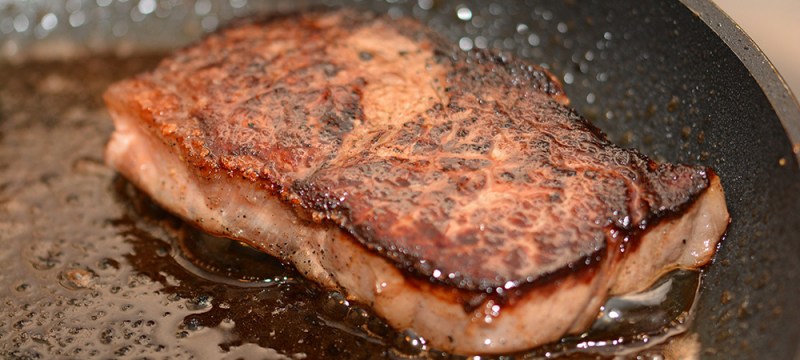Stovetop or grilling are the classic ways to cook a steak, but when you’re at home, the constant attention this method requires can be disheartening! Thick cuts of steak that are at least one inch thick, such as filet mignons, T-bones, ribeyes and strips, can turn out just as juicy and tasty being roasted in the oven, but with much less maintenance, leaving time to get the rest of the meal ready.
Pick Your Steak Wisely

No matter how you cook a steak, the result will only be as good as the product — if you buy a cheap steak, don’t expect it to taste anything but cheap. Buy a quality piece of meat from your local butcher or go to a store with an excellent meat source.
The Perfect Prep For A Perfect Steak
Before you begin cooking, some preparations are in order if you want your steak to turn out as tasty as can be.
Make Sure Your Steak Is Nice And Dry
Many people believe that the starting temperature of a piece of meat affects how it will cook, but that is false –what is actually important is how dry it is. The best way to dry out your steak before cooking is by thoroughly blotting it with a paper towel and then generously salting it about 40 minutes before the cooking begins. This is enough time for the salt to draw the liquid in the steak out, then let it reabsorb inside. The dryer the surface of the steak upon cooking it, the juicier it will be when you eat it.
Seasoning Your Meat

If you plan in advance, a good steak marinade will make the meat unbelievably tasty. When the time for cooking the steak comes, if salt isn’t enough, there’s a couple of seasoning tricks that will put your steak on the right track. Use olive oil to rub into each side of the steak and season with plenty of freshly ground pepper, salt and garlic powder.
Cooking The Steak
Now, it’s time for the main event — the actual cooking of the steak.
Sear Your Steak

The first step to a great steak is giving it a good sear. Place a cast iron or stainless steel skillet in the oven and preheat it to 400 degrees. When it reaches the desired heat, take it out carefully, turn on a stovetop burner to high heat, and use tongs to put the steak in the hot pan. Leave it sizzling on one side for about one minute. Then flip it over and let it sizzle on the other side for another minute.
Transfer Your Steak To The Oven
When the searing is done, take the skillet with the steak in it and place it back in the oven, making sure it’s flat. Leave the steak in the oven for anywhere from five to 15 minutes, flipping it halfway through. How long you leave it in depends on two things: how thick the steak is and how you like your steak done –the thicker the steak, the longer it will take for the center of it to cook. Cooking the meat for two and a half minutes on each side for a thick steak will make it around medium-rare. Add another two and half minutes to each side to get it closer to medium, and another two and half minutes to each side for medium-well. For a well-done steak, around 20 minutes total in the oven is probably necessary.
The Post-Pan Procedure
Before eating, some additional care for your steak is highly recommended.
Let The Steak Rest
Take the steak out of the oven and out of the skillet, placing it on a large cutting board. Make a loose tin foil tent over the steak and let it rest for at least five minutes, or 10 minutes if you have the time. The loose tin foil tent keeps it from cooling down too much and losing too much moisture. If you leave the steak in the skillet to cool, it will continue cooking, so it’s best to remove it when it’s already done to your liking. If butter on steaks is your style, place a pat of butter on top of the steak inside of the tin foil while it is resting.
This step is essential to keeping your steak as juicy as possible. While the steak is cooking, its juices are driven to the center. During these five minutes of rest, the juices are reabsorbed throughout the whole cut of meat, which will result in it losing less liquid when it is cut.
Slice And Serve The Steak

Slice your steak against the grain before using tongs to transfer it to the plate. Slicing meat against the grain cuts through the fibers of the meat and shortens them, making it easier to chew. Plus, using tongs instead of a fork to transfer the steak from the cutting board to the plate will result in less of the meat’s juices being lost.
Now it’s time to enjoy your perfectly oven-cooked steak.
